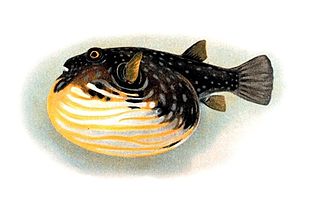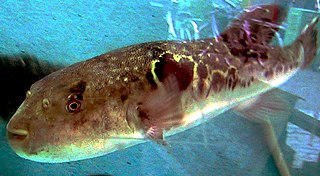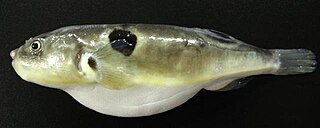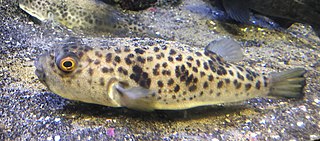
Tetraodontidae is a family of primarily marine and estuarine fish of the order Tetraodontiformes. The family includes many familiar species variously called pufferfish, puffers, balloonfish, blowfish, blowers, blowies, bubblefish, globefish, swellfish, toadfish, toadies, toadle, honey toads, sugar toads, and sea squab. They are morphologically similar to the closely related porcupinefish, which have large external spines. The scientific name refers to the four large teeth, fused into an upper and lower plate, which are used for crushing the hard shells of crustaceans and mollusks, their natural prey.

Takifugu, also known by the Japanese name fugu, is a genus of pufferfish with 25 species, most of which are native to salt and brackish waters of the northwest Pacific, but a few species are found in freshwater in Asia or more widely in the Indo-Pacific region. Their diet consists mostly of algae, molluscs, invertebrates and sometimes crustaceans.

Dichotomyctere ocellatus, commonly the figure 8 puffer or eyespot puffer, is a pufferfish found in freshwater in Southeast Asia. It is known from the lower reaches of the Mekong (Cambodia), the Peninsular Malaysia as well as Borneo.

Takifugu rubripes, commonly known as the Japanese puffer, Tiger puffer, or torafugu, is a pufferfish in the genus Takifugu. It is distinguished by a very small genome that has been fully sequenced because of its use as a model species and is in widespread use as a reference in genomics.

The grass puffer, or Kusa-fugu, is a species of fish in the pufferfish family (Tetraodontidae). This common to abundant species is found in the northwest Pacific Ocean in China, Japan, Korea, the Philippines and Vietnam. It is primarily found in coastal waters, ranging to depths of 20 m (66 ft), but is often seen in brackish water and has also been recorded briefly entering freshwater. The grass puffer reaches up to 15 cm (6 in) in length.

Takifugu vermicularis, the purple puffer, is a species of pufferfish native to the northwest Pacific Ocean where it occurs in the waters around China, Taiwan, the Republic of Korea and Japan. This species is of commercial importance though the flesh is toxic. This species grows to a length of 30 centimetres (12 in) SL.

Vermiculation is a surface pattern of dense but irregular lines, so called from the Latin vermiculus meaning "little worm" because the shapes resemble worms, worm-casts, or worm tracks in mud or wet sand. The word may be used in a number of contexts for patterns that have little in common. The adjective vermiculated is more often used than the noun.
T. vermicularis may refer to:
Takifugu chinensis, the Chinese puffer, is a species of fish in the family Tetraodontidae (pufferfish) that is found in coastal waters of China, Japan and Korea. This critically endangered pufferfish has drastically declined because of overfishing and habitat loss, but it is possibly also threatened by the widespread release/escape of aquacultured Takifugu rubripes within its range. These two species are similar, very closely related and perhaps should be considered conspecific, but they do differ in the colour of their anal fins.

Takifugu poecilonotus, the finepatterned puffer, or Komon-fugu, is a species of pufferfish, one of 25 in the genus Takifugu. It is found in the northwest Pacific Ocean at shallow depths up to 20m. It contains tetrodotoxin like other members of the genus Takifugu. This species is found in fresh, brackish and saltwater environments.

Takifugu obscurus or the obscure pufferfish is a species of euryhaline, anadromous pufferfish first described by T. Abe in 1949. It has been categorized by the IUCN as a least-concern species globally since 2014; in South Korea, it is however classified as an endangered species due to overfishing of its endemic populations. The Catalogue of Life lists no subspecies of Takifugu obscurus. The species prefers deeper, clearer areas of brackish and fresh water, and is found in estuaries, as well as rivers and tributaries thereof such as the South Korean rivers Geum, Han, and Imjin, or the Tamsui River. The species is endemic to North and South Korea, the Sea of Japan, and the East and South China Seas. Uses of Takifugu obscurus include human consumption, use in animal testing, and owning specimens as pets. As with most species of pufferfish, several organs of Takifugu obscurus contain tetrodotoxin, making it potentially poisonous if not prepared safely by trained persons.
Pao hilgendorfii, sometimes known as Hilgendorf's puffer, is a species of pufferfish in the family Tetraodontidae. It is a tropical freshwater species native to the Mahakam basin in Borneo. The species was originally described as a member of Tetraodon but was moved to the then-new genus Pao in 2013.

Takifugu alboplumbeus, sometimes known as the grey-spotted puffer, is a species of pufferfish in the family Tetraodontidae. It is a marine species native to the Indo-Pacific that reaches 23 cm SL. It is known to be highly toxic.

Takifugu chrysops is a species of pufferfish in the family Tetraodontidae. It is a marine species known from Japan, where it ranges from Tosa Bay to Tokyo Bay. It is a demersal fish that reaches 20 cm SL. Although sometimes known as the red-eyed puffer, this can lead to confusion with several freshwater species of the genus Carinotetraodon.
Takifugu coronoidus is a species of pufferfish in the family Tetraodontidae. It is a brackish-water species known from China that was first described by Y. Li and C. S. Ni in 1992. In Chinese, the species is known as "晕环多纪鲀", which translates to "halo pufferfish".
Takifugu orbimaculatus is a species of pufferfish in the family Tetraodontidae. It is a freshwater species native to China that is known to be used medicinally. In 2009, it was determined that Takifugu orbimaculatus is likely to be very closely related to its congeners T. coronoidus and T. obscurus based on molecular phylogenetic analyses, with genetic differences between these species being almost comparable to those between individuals of the same species.

Takifugu pardalis, known as the panther puffer, is a species of pufferfish in the family Tetraodontidae. It is a marine species native to the Northwest Pacific, where it ranges from Hakodate in Japan to the Yellow Sea and the East China Sea. It is demersal, occurring in coastal rocky areas, and reaches 30 cm SL. It is known to be poisonous. Both the scientific and common name of this species reference its distinctive spotted pattern, which resembles that of a leopard.

Takifugu porphyreus, known as the purple puffer, is a species of pufferfish in the family Tetraodontidae. It is native to the Northwest Pacific, where it ranges from Hokkaido to the East China Sea. It is a demersal species found in the littoral zone that reaches 52 cm in total length. While parts of the fish are highly toxic, it is frequently consumed as fugu in Japan.













